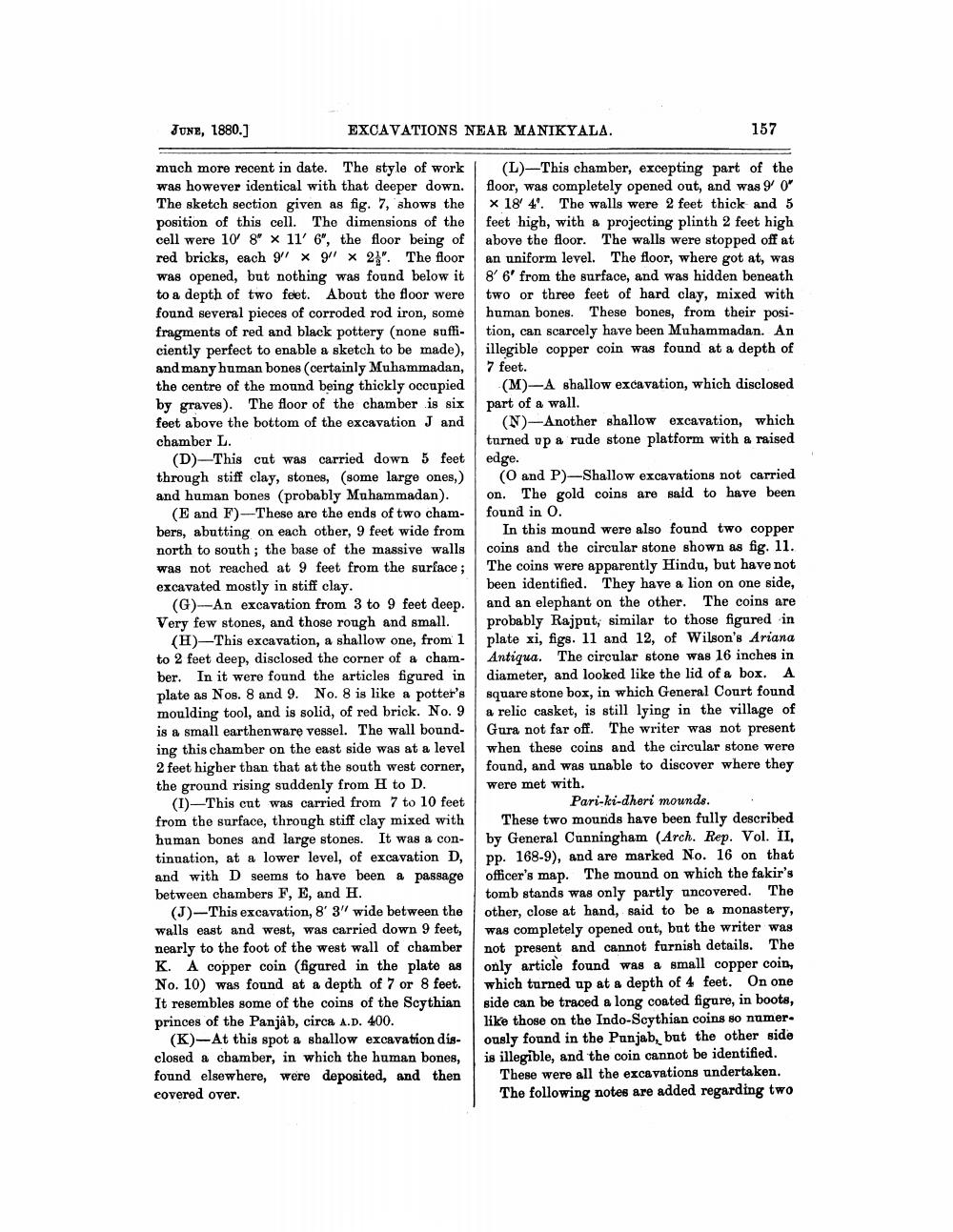________________
June, 1880.]
EXCAVATIONS NEAR MANIKYALA.
157
much more recent in date. The style of work (L)-This chamber, excepting part of the was however identical with that deeper down. floor, was completely opened out, and was 90' The sketch section given as fig. 7, shows the * 18 4'. The walls were 2 feet thick and 5 position of this cell. The dimensions of the feet high, with a projecting plinth 2 feet high cell were 10' 8" X 11' 6", the floor being of above the floor. The walls were stopped off at red bricks, each 9' X 9' X 2". The floor an uniform level. The floor, where got at, was was opened, but nothing was found below it 8' 6' from the surface, and was hidden beneath to a depth of two feet. About the floor were two or three feet of hard clay, mixed with found several pieces of corroded rod iron, some human bones. These bones, from their posifragments of red and black pottery (none suffi- tion, can scarcely have been Muhammadan. An ciently perfect to enable a sketch to be made), illegible copper coin was found at a depth of and many human bones (certainly Muhammadan, | 7 feet. the centre of the mound being thickly occupied (M)-A shallow excavation, which disclosed by graves). The floor of the chamber is six part of a wall. feet above the bottom of the excavation J and (N)-Another shallow excavation, which chamber L.
turned up a rude stone platform with a raised (D)-This cut was carried down 5 feet edge. through stiff clay, stones, (some large ones) (O and P)-Shallow excavations not carried and human bones (probably Muhammadan). on. The gold coins are said to have been
(E and F)-These are the ends of two cham- found in 0. bers, abutting on each other, 9 feet wide from In this mound were also found two copper north to south; the base of the massive walls coins and the circular stone shown as fig. 11. was not reached at 9 feet from the surface ; The coins were apparently Hindu, but have not excavated mostly in stiff clay.
been identified. They have a lion on one side, (G) An excavation from 3 to 9 feet deep. and an elephant on the other. The coins are Very few stones, and those rough and small. probably Rajput, similar to those figured in
(H)-This excavation, a shallow one, from 1 plate xi, figs. 11 and 12, of Wilson's Ariana to 2 feet deep, disclosed the corner of a cham- Antiqua. The circular stone was 16 inches in ber. In it were found the articles figured in diameter, and looked like the lid of a box. A plate as Nos. 8 and 9. No. 8 is like a potter's square stone box, in which General Court found moulding tool, and is solid, of red brick. No. 9 a relic casket, is still lying in the village of is a small earthenware vessel. The wall bound- Gura not far off. The writer was not present ing this chamber on the east side was at a level when these coins and the circular stone were 2 feet higher than that at the south west corner, found, and was unable to discover where they the ground rising suddenly from H to D. were met with. (I)-This cut was carried from 7 to 10 feet
Pari-ki-dheri mounds. from the surface, through stiff clay mixed with These two mounds have been fully described human bones and large stones. It was a con- by General Cunningham (Arch. Rep. Vol. II, tinuation, at a lower level, of excavation D, pp. 168-9), and are marked No. 16 on that and with D seems to have been a passage officer's map. The mound on which the fakir's between chambers F, E, and H.
tomb stands was only partly uncovered. The (J)-This excavation, 8' 3'' wide between the other, close at hand, said to be & monastery, walls east and west, was carried down 9 feet, was completely opened out, but the writer was nearly to the foot of the west wall of chamber not present and cannot furnish details. The K. A copper coin (figured in the plate as only article found was a small copper coin, No. 10) was found at a depth of 7 or 8 feet. which turned up at a depth of 4 feet. On one It resembles some of the coins of the Scythian side can be traced a long coated figure, in boots, princes of the Panjab, circa A.D. 400.
like those on the Indo-Scythian coins so numer (K)-At this spot a shallow excavation dis- ously found in the Punjab, but the other side closed a chamber, in which the human bones, is illegible, and the coin cannot be identified. found elsewhere, were deposited, and then These were all the excavations undertaken. covered over.
The following notes are added regarding two




